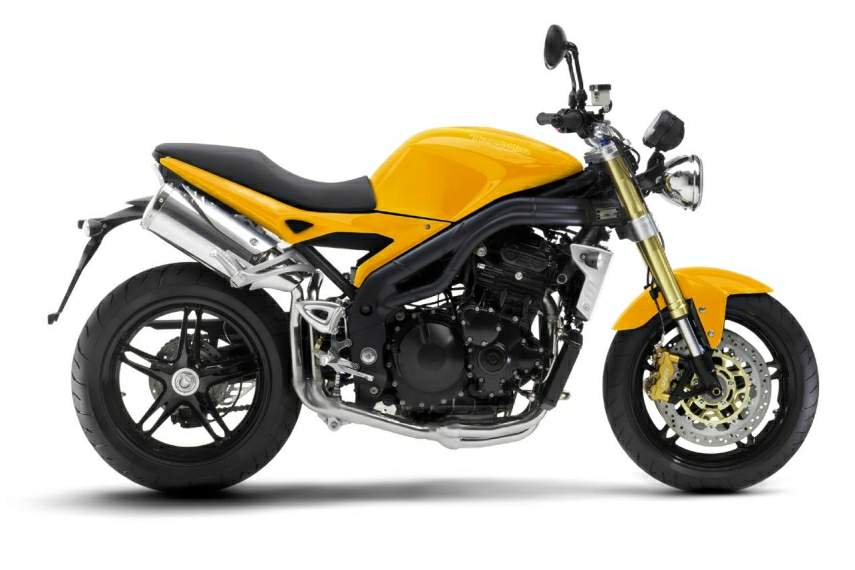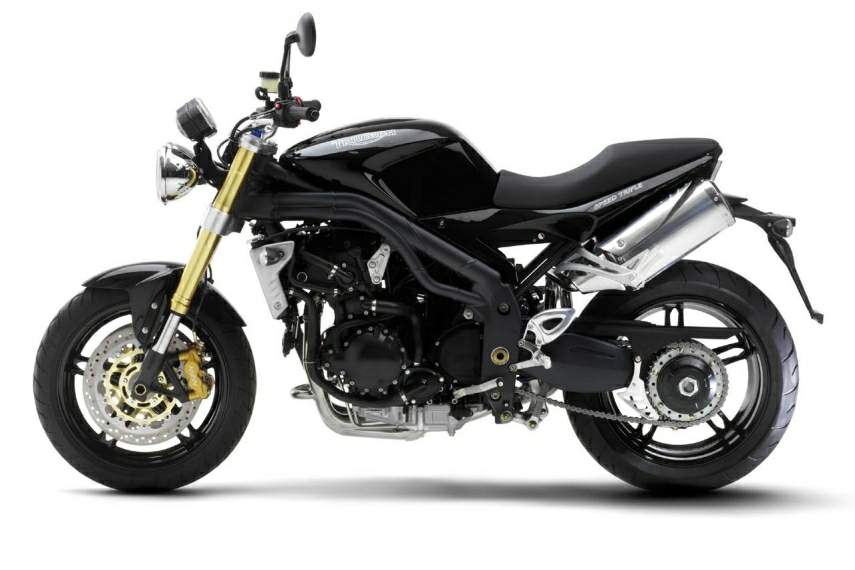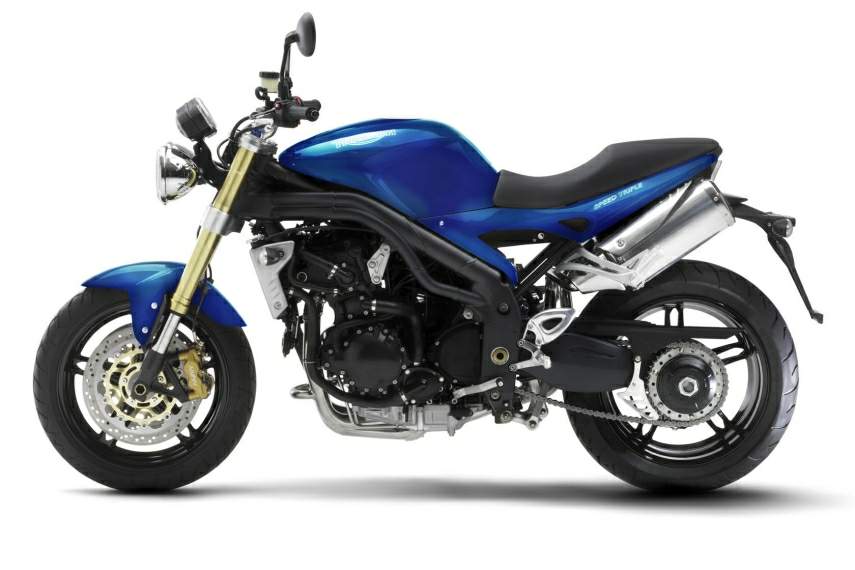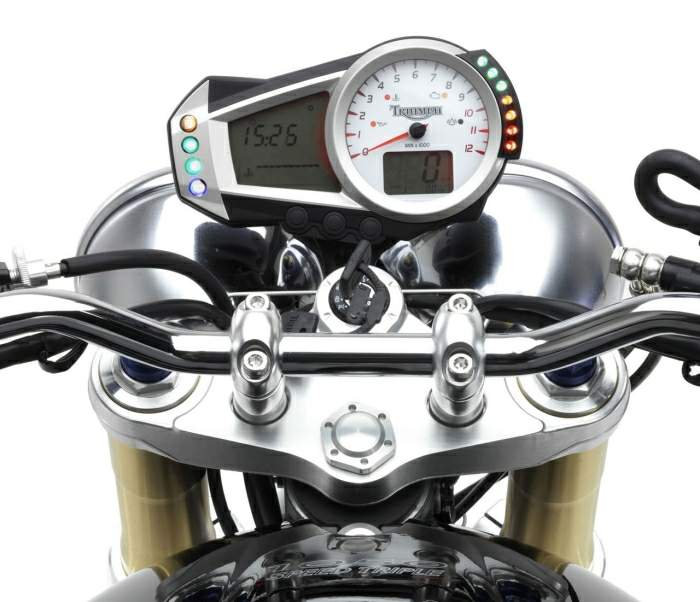
|
|
|
|
|
|
Classic Bikes
Custom Bikes
Individual
Racing Bikes AJP
AJS
Aprilia
Ariel
Avinton / Wakan
Bajaj
Benelli
Beta
Bimota
BMW
Brough Superior
BRP Cam-Am
BSA
Buell / EBR
Bultaco
Cagiva
Campagna
CCM
CF Moto
Combat Motors
Derbi
Deus
Ducati
Excelsior
GASGAS
Ghezzi Brian
Gilera
GIMA
Harley Davidson
Hero
Highland
Honda
Horex
Husaberg
Husqvarna
Hyosung
Indian
Jawa
Kawasaki
KTM
KYMCO
Laverda
Lazareth
Magni
Maico
Mash
Matchless
Mondial
Moto Guzzi
Moto Morini
MV Agusta
MZ / MuZ
NCR
Norton
NSU
Paton
Peugeot
Piaggio
Revival Cycles
Roland Sands
Royal Enfield
Sachs
Sherco
Sunbeam
Suzuki
SWM
SYM
Triumph
TVS
Ural
Velocette
Vespa
Victory
Vincent
VOR
Voxan
Vyrus
Walt Siegl
Walz
Wrenchmonkees
Wunderlich
XTR / Radical
Yamaha
Zero
Video
Technical
Complete Manufacturer List
|
Triumph Speed Triple
|
| . |
|
Make Model |
Triumph Speed Triple |
|
Year |
2005 |
|
Engine |
Four stroke, transverse three cylinder. DOHC, 4 valves per cylinder |
|
Capacity |
1050 cc / 64.07 cu-in |
| Bore x Stroke | 79 x 71.4 mm |
| Cooling System | Liquid-cooled |
| Compression Ratio | 12.0:1 |
| Lubrication | Wet sump |
| Engine Oil | 10W/40 Synthetic |
|
Induction |
Multipoint sequential electronic fuel injection |
|
Ignition |
Digital inductive type |
| Spark Plug | NGK, CR9EK |
| Starting | Electric |
|
Max Power |
94.9 kW / 131 hp @ 9100 rpm |
|
Max Torque |
105 Nm / 10.7 kgf-m / 78 ft-lb @ 5100 rpm |
| Clutch | Wet, multi-plate |
|
Transmission |
6 Speed |
| Final Drive | Chain |
| Frame | Tubular, fabricated aluminum alloy, perimeter |
|
Front Suspension |
45 mm Upside down forks with dual rate springs and adjustable preload, compression and rebound damping |
| Front Wheel Travel | 120 mm / 4.7 |
|
Rear Suspension |
Monoshock with adjustable preload, compression and rebound damping |
| Rear Wheel Travel | 140 mm / 5.7 in |
|
Front Brakes |
2 x 320 mm Discs, 4 piston calipers |
|
Rear Brakes |
Single 220 mm disc, 2 piston caliper |
|
Front Tyre |
120/70 ZR17 |
|
Rear Tyre |
190/50 ZR17 |
| Rake | 24° |
| Trail | 84 mm / 3.3 in |
| Dimensions |
Length 2115 mm / 83.3 in Width 780 mm / 30.7 in Height 1250 mm / 49.2 in |
| Wheelbase | 1429 mm / 56.3 in |
| Seat Height | 815 mm / 32.1 in |
|
Dry Weight |
189 kg / 416.7 lbs |
|
Fuel Capacity |
18 Litres / 4.89 gal |
|
Standing ¼ Mile |
11.8 sec |
|
Top Speed |
248.7 km/h / 154.5 in |
| Reviews | Motorcyclist / Motorcycle-USA |
| . |
As soon as you release the clutch on the new Speed Triple, it is clear that every outing could end with jail time. The old 955cc version with its big power and ready-for-action upright riding position held a special place in the dark confines of the hooligan's heart, but this new one with a stouter chassis and more displacement will displace it.
The changes don't seem so dramatic-just 95cc here, a flipped fork there and a
styling nip and tuck. But the sum of these tweaks has led to a much-improved
motorcycle.
Even with the limited mileage offered by the snow-shortened press introduction
in the South of France (see sidebar), it was clear the Speed Triple had elevated
the thug's game. After this brief-but-enticing taste, we immediately arranged
for a day-ride on a stateside loaner and had our initial impressions confirmed:
The new 1050cc Speed Triple kicks ass, while also being much more refined than
the previous model.
See, as much as we loved the old "Trip," it was always a little rough around the edges. Throttle response could be abrupt and the shock harsh, while below-the-waistline "styling" left some unattractive fluid plumbing and front turnsignal mounts that were, if you'll excuse the invented word, "affrontational." New styling cleans up the signal mounts and engine, while giving the bike a new twist on the old punk theme. It clearly remains a Speed Triple (twin headlights, of course!), even with its new docked tail, five-spoke rims and twin, upswept exhausts with stainless silencers.
"We wanted to give the impression of riding an engine with wheels," said Product Manager Ross Clifford about the new 1050cc Tripper.
This thug is livin' clean: Exhaust catalyzers in the stainless exhaust system reduce emissions from the 128-horsepower, 1050cc inline-Triple.
Mission accomplished. For not only is the engine the visual anchor, it is the magic center of the Speed Triple's goodness. The dohc inline-Three's sound is throaty, delicious, deep and full of power and gruff soul like Pavarotti after, say, 1050 non-filtered ciggies. Response is immediate and hearty. From 2000 rpm in the lower gears, the Speed Triple jumps forward. Despite the 6.4mm-longer stroke, the bigger engine is smoother than the previous version. In fact, it's really easy to smack into the 10,000-rpm rev-limiter.
"Everything is new," said Clifford about the liquid-cooled engine. A redone cylinder head features altered port shapes, while recast cases contain the new stroker crank. Outer covers now have crisp edges, while some of the formerly exposed coolant lines have been rerouted to the back of the engine or up under the 4.7-gallon fuel tank. The oil-cooler is now located under the radiator rather than hung off the engine's right side. The major coolant hoses on the left remain, but ya gotta have coolant and ya gotta have a radiator if you want to make a claimed 128 horsepower and 78 foot-pounds of torque reliably from a liter-class engine.
Like the recently introduced Sprint ST (CW, May)
that uses the same engine, the Speed Triple now features Keihin EFI, which
Triumph goes to great pains to point out was developed specifically for
motorcycle use, unlike the previous Sagem setup. There was only the mildest
hiccup right off idle, but after that the show was on. Ask with the new
quick-action twistgrip, and ye shall receive quick action at the rear wheel.
Tuning of the EFI is much more aggressive than with the sport-touring ST, which
was softened for its more mellow duty. We'll take instant gratification any day.
Which is something you definitely get from the chassis, along with a much nicer
ride and improved composure. Retained is the characteristic tubular-aluminum
frame construction and previous sporty geometry (23.5-degree rake/3.3-inch
trail), but new castings drop weight a few pounds (claimed dry weight is
unchanged at 416 pounds). The single-sided swingarm is redesigned for visual
reasons, but lost some length in the process so wheelbase is slightly shorter at
56.3 inches. More important to the overall riding experience are the new 45mm
inverted fork (held in place by a stout, three-bolt lower triple-clamp) and
retuned rear suspension, which take out the harshness of the old bike while
adding improved front-end feel and a comparatively gliding ride. The fully
adjustable fork and shock aren't soft by any means—Triumph just removed some of
the square-edge-induced pain from this very sporty setup.

Fitted to that fork you will note is a pair of radial-mount Nissin four-piston
calipers working on 320mm discs. There is great glory in their power, but as
with the Sprint ST, lever travel is too great and response a little
counterintuitive. Clifford said engineers tuned the brakes for a more
progressive feel than your typical hard-lever/aggressive-response radial setup,
but they went a bit too far for our taste, eliciting the dreaded "mushy"
response from one tester when asked to describe the feeling at the adjustable
lever. Outright power is there, but the in-between stages are just a little off.
Small stuff in the grand scheme—don't let the brakes stop you from getting a
Speed Triple.
Following a trend we are happy about, the rear rim has been reduced in width
from a 6-incher to 5.5, and a Michelin Pilot Sport 180/55ZR17 tire fitted.
Dropping a size from a 190 as Triumph did here almost always has a positive
effect on steering, usually making it lighter and more neutral. With the wide
bars, minimal trail and new narrower rear tire, steering is definitely light.

At $9999, the Speed Triple is $1400 more expensive than our perennial
sport-standard favorite, the Yamaha FZ1, and $1000 cheaper than our other
perennial favorite, the air-cooled Ducati Monster 1000S, which has 34 less
claimed horsepower.
That's a pretty good value on the Triumph's part, considering the elements
brought to the table by the new bike-more power, better throttle response,
improved suspension and fresh styling-giving the Speed Triple a much-needed
elevation in performance and re-affirmation of its street cred. It's got an
excellent riding position, and with that moto-style tubular bar, there's no
telling what you can get away with. The Scorched Yellow and Neon Blue colors are
hot, but you might be better off with Jet Black to keep a low profile. No matter
what you do, work on your use of the word "allegedly." It's going to come in
handy.
Such strange tragedies are rarely known in this
business, for when press introductions are scheduled, even in early March, they
always are in places where the world has confidence in the attendance of fine
weather along with the world's scoot-jockey typists. And the South of France has
been a reliable source of motorbiking ambience. Until now.
A Triumph rep warned us it would be cold in Marseilles, and it was evident on
this sub-freezing morning (lowest temps since '71, went the rumor) that my
Aerostich electric vest and lined Alpinestars leather jacket were going to come
in mighty handy. But who would have thought to pack a parka and snowboard?

The first little flakes began to fall at our departure gas stop. By the time we
got into the hills, big, fluffy tufts of snow were blanketing parked bikes and
sticking to the road. We cracked off a few photo passes, because that's what you
do in this job no matter what, then headed up the road to an even higher
elevation for possibly more photos.
Turns out snow is slick. As I released the clutch to get under way behind the
moving photo van on the now fully snow-covered road, the rear tire spun lazily,
yet uncontrollably. This, without any throttle. The bike rotated and I put my
feet down to try to hold it up and I believe I spun nearly 180 degrees while
upright, traveling in semi-reverse down the road briefly. Alas, the burden was
too great and gently the 2005 Speed Triple and I reclined at low velocity in the
snow. The worst of it was when my e-vest came unplugged, letting in the chill.
It was the official end to riding for everyone. We shuttled back to the hotel
stuffed into rental cars, while four inches of snow accumulated on the parked
bikes before the Triumph factory truck could fetch them from the mountain.
At least I have my Christmas card picture this year.
Source Cycle World

|
Any corrections or more information on these motorcycles will be kindly appreciated. |